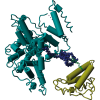An immune response that likely evolved to help fight infections appears to be the mechanism that drives human immunodeficiency virus (HIV) into a latent state, researchers at Duke Health in the US report.

“HIV has proven to be incurable because of a small number of latently HIV-infected T-cells that are untouched by both antiviral drugs and the immune response,” said senior author Bryan R. Cullen, Professor in the Department Molecular Genetics and Microbiology.
“These cells, which are very long lived, can spontaneously emerge from latency and start producing HIV even years after infection, thus necessitating the life-long use of antiretrovirals. The origin of these latently infected cells has remained unknown despite considerable effort.”
The findings from Cullen and colleagues offer important insights, pointing to a protein complex called SMC5/6, which is involved in a host cell’s chromosome function and repair.
Cullen and his team found that, in a small number of infected cells, the SMC5/6 protein complex initiates a process that silences the DNA provirus before it goes on to integrate into a host cell chromosome.
These proviruses remain inert even after integration and result in latent infections, lying low until prompted to erupt into an active infection.
Image credit | Science Photo Library




